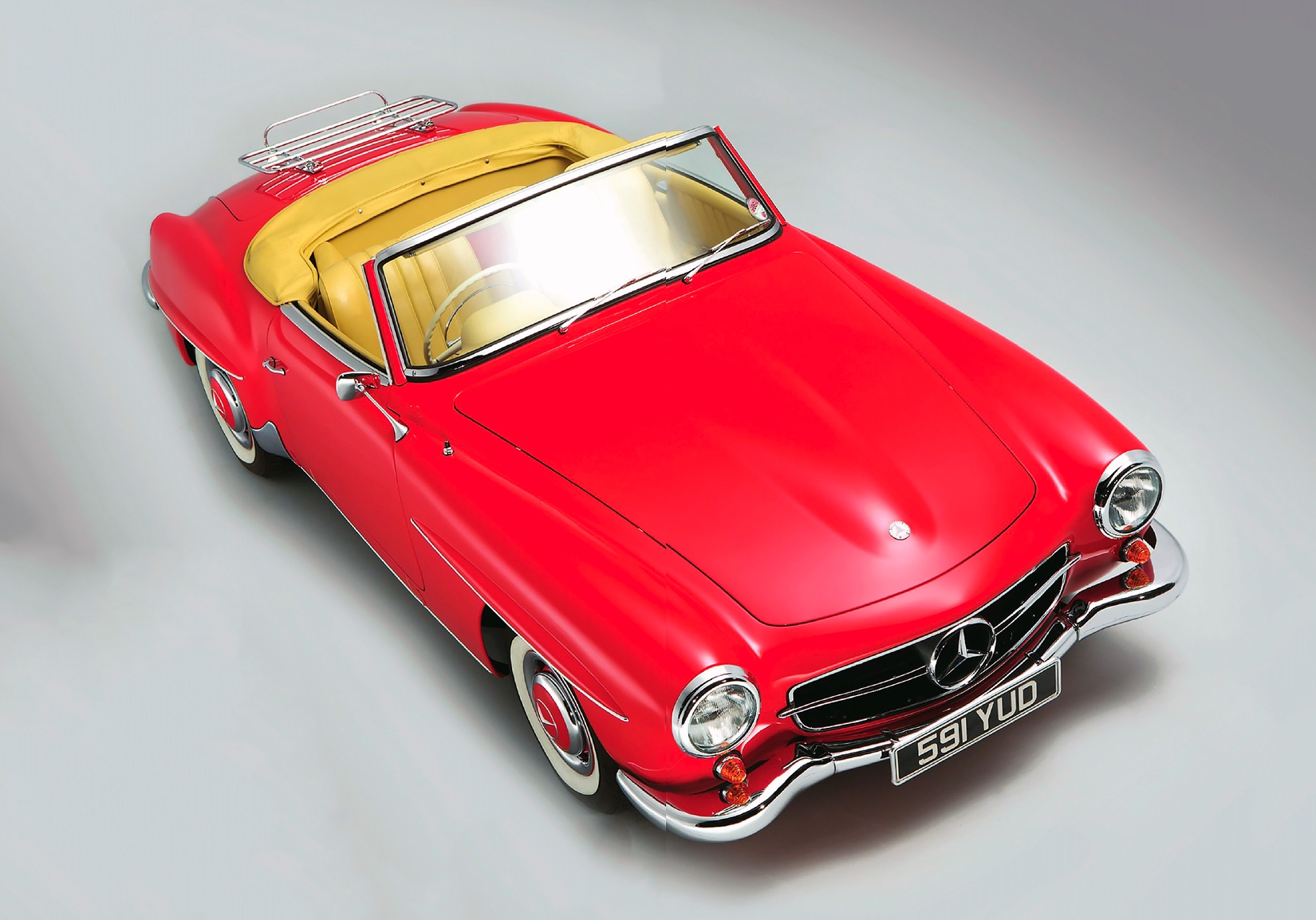
Using Ponton underpinnings, the exceptionally pretty W121 was designed as a mass-produced, affordable version of the space-framed 300SL, and proved a key sports car of the 1950s, says David Sutherland – 25,881 190SLs had been built in a production life three months short of eight years, with the majority of cars going to the US.
Mercedes-Benz hobbled into the 1950s a very much reduced industrial entity, its factories 80 per cent destroyed in World War Two, and its 1930s swagger vanquished. Indeed the 1948 annual report concluded that, practically speaking, the company ceased to exist.
Yet within five years Mercedes had almost totally reinvented itself. Its pre-war grand prix racing dominance had been restored (although this came to a premature end following the 1955 Le Mans tragedy, in which many people died), and the quite sensational 300SL Coupe, or ‘Gullwing’, launched in 1954 amply demonstrated that even with its pared down financial muscle compared to pre-war resources, the company was still a technology’ leader.

The 1958 annual report concluded that, practically speaking, the company ceased to exist. Yet within five years Mercedes had almost totally reinvented itself.
Owner Wolfgang Rauch
A minor front end shunt was the spur for a full, ground-up restoration.
The collection of Mercedes classics built up by Wolfgang Rauch, who runs a commercial packaging systems company, was already considerable, comprising a 1950s’ 300S Coupe, a W198 300SL Roadster, three 280SL Pagodas, a W111 300SE Cabriolet, and an R107 300SL. But he hankered after one obvious omission, a W121 190SL.
In 2000, “after looking all over the place”, he found this 1961 car in the Lake District and liberated it to Surrey, where he lives ” I liked the colour – but when I got it home I realised it needed a lot of love,” he recalls.
Nothing was done for a year or so, until the unexpected happened. “I drove into the car in front,” Rauch admits. “It wasn’t serious – even without a seat belt I wasn’t hurt – but after that I decided to give it a total restoration “That was carried out by classic car restorer Rees Bros in Aldershot in Hampshire, over an extended period, with many of the parts refurbished in Germany. “Not a nut or a bolt went without attention, and it took so long that by the time it was finished I didn’t need to mention the accident for my insurance because it had been over five years earlier,” he adds. Meanwhile, he bought another 190SL, a white one.
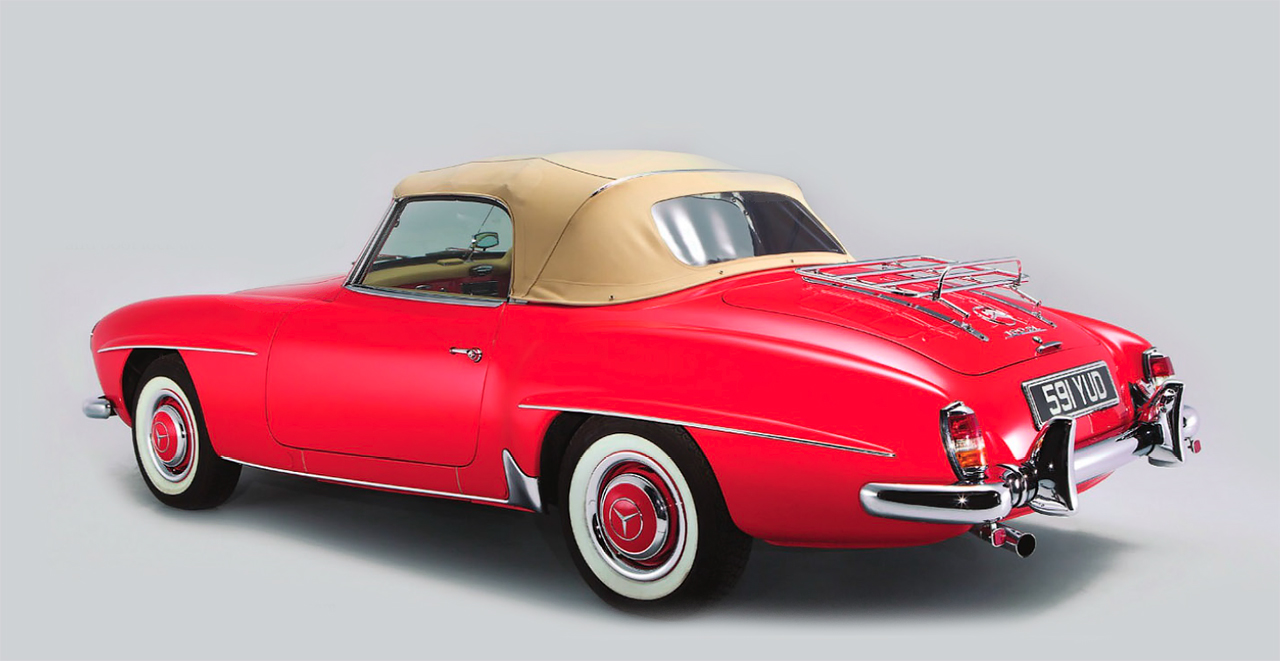
So far, Wolfgang had not been a Mercedes-Benz Club member, or bothered with concours competitions, but that changed when he joined the club to obtain some assistance with certification on two of his other cars.
“I decided to attend the 190SL Day at Brooklands, as it was local to me, to have a look at how other 190SLs compared to mine, and won Best of Show,” he says. That led to an attendance at the club’s 2013 National Concours Day at Mercedes’ headquarters in Milton Keynes in June, where he won the Older Sports Cars category, after which the 190SL’s presence was requested on the club’s stand at the Classic Motor Show at the NEC in Birmingham last November.
How does Wolfgang rate this 190SL compared to his other classics? “It’s one of the easiest to drive – the 300SL is much more temperamental, and you have to keep the revs up,” he says.
The 1953 Ponton, with its monocoque construction and passenger safety cell, had re-established the carmaker as a credible force in the mainstream market. This four-door, ‘three-box’ saloon highlighted the four-cylinder 170-and six-cylinder 220-series models, and even the 300 Adenauer, with their running boards and separate wings as the pre-war designs they essentially were. Daimler-Benz was riding the wave of West Germany’s Wirtschaftswunder (‘economic miracle’), its optimism and confidence not only reflected in its new models but in the way in which it was building itself into an international company, opening a factory in Argentina, with Brazil and India to follow shortly. Even West Germany’s victory in football’s World Cup of 1954, hosted by Switzerland and noted in history it’s the ‘Miracle of Bern’, helped sum up the country’s transformation.

While the Gullwing was Mercedes engineering showcase, and would be built in small numbers (1,400 by the end of its four-year run in 1957), it became increasingly clear, even before die 300SL s launch, that there would be strong demand for a less exotic, more affordable stablemate. At least, it was obvious to Mercedes’ visionary US importer, the Austrian born Max Hoffman, who earlier had persuaded Stuttgart to turn the 1952 300SL race car, with its top-hinged doors, into the road-going 300SL Coupe, and who history credits as the man who made the resultant car, the 190SL, happen as well.
Appropriately, the W121 190SL was unveiled in New York, at the International Motor Sports Show in February 1954 – actually, at the same time it’s the 300SL Coupe W198 made its debut, although, with engineering and design work still to do, it did not go into production until May of the following year. By the time it was finally launched it had lost the bonnet air intake of the 1954 show car, but gained ‘winglets’ above the rear wheelarches, to match those at the front, and its launch price was DM16,500 (around £1,400) compared to the 300SL’s DM29,000 (£2,500).
The 190SL, styled by Mercedes designers Walter Hacker and Karl Wilfert, looked like a scaled down 300SL (and was also very similar to the 300SL Roadster that would replace die Gullwing in 1957). But while the 300SL used a weight saving, light-alloy space frame, in view of the 190SLs higher production aspirations, it was far more mundane in construction. Indeed, it was based on the platform of the four-cylinder Ponton model of the time, the W120 180. It used that car’s front subframe and axle – an innovative design that went some way toward isolating vibration from the rest of the car – although was not powered by the same 1.8-litre engine, but instead a new 1.9-litre four-cylinder unit. This was fuelled by twin Solex carburetors and good for 104bhp, just over double the saloon’s output. That, however, was approximately half the horsepower of the 300SL’s fuel-injected, three-litre engine, and the 105lb ft was a similar fraction.
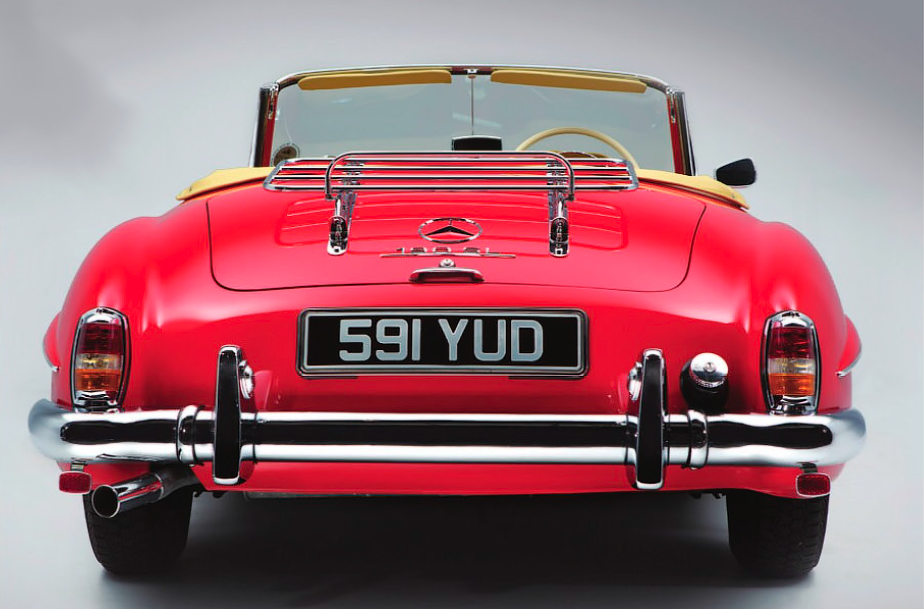
There were two regular versions of the 190SL, a Roadster with a canvas hood, and a Coupe with a removable hardtop, the hood an option on the latter model. No doubt with a competitor to Porsche’s 356 Speedster club racer in mind, in the first year of production Mercedes also offered a racing conversion kit, comprising light alloy doors and twin Plexiglas flyscreens, the idea being that besides fitting these in place of the original doors and screen, owners would also remove the bumpers and other items to save weight. But according to leading 190SL specialist Redcastle Classics in Wales, only a handful of these kits were delivered, probably because the modifications would have pitched the 190SL into the GT class, in which it would have stood no chance due to its limited output Replaced by the W113 SL in 1963, 25,881 190SLs had been built in a production life three months short of eight years, with the majority going to the US. The car never underwent a facelift, all updates being minor. In 1956 new chrome strips appeared on the upper section of the doors, and the Ponton 220 s larger rear lamps were fitted, while a year later the number plate panel was enlarged and its light set in the bumper. In 1959 the hardtop gained a bigger screen and, finally, in 1960 the door handles and boot lock were modified.
Marque of shame
1957 saw Mercedes fleetingly associated with the seamier side of life
The Mercedes-Benz image took a wobble when the 190SL was found to be at the heart of one of West Germany’s first major scandals in the post-war period. It was the favoured transport of a high society prostitute named Rosemarie Nitribitt (pictured), who after an impoverished and traumatic childhood went on to ply her trade in Frankfurt so successfully that she became sufficiently wealthy to maintain an affluent lifestyle. The black 190SL she bought in 1956, made even more distinctive by red leather upholstery and whitewall tyres, was said to have been used in the course of her soliciting clients.

But she was found murdered in November 1957 in her luxury apartment in Frankfurt, after which police investigations revealed a number of prominent figures, including the then head of the Krupp industrial corporation, to have been among Nitribitfs alleged associates. The case, arguably the German equivalent of the 1963 Profumo affair in the UK, shocked a then quite prudish German public, particularly as no successful prosecution was brought, and also because there were allegations of a cover-up by some of the well known people involved. For a while afterwards the 190SL was commonly referred to as the ‘Nitribitt-Mercedes’, and to this day the whereabouts of Nitribitfs car, impounded by police at the time, is unknown.
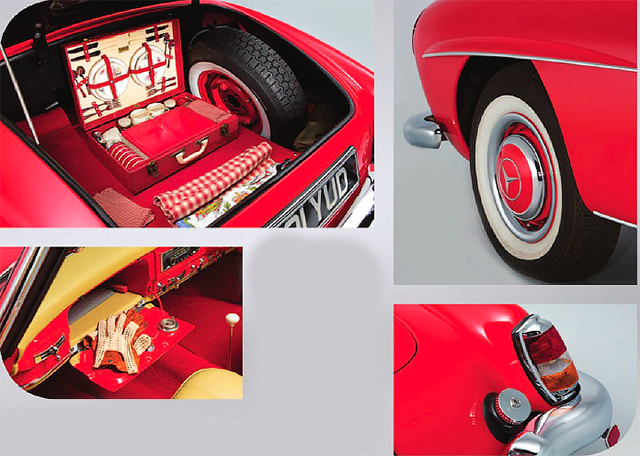
Clockwise from above – the delightful picnic set is one the owner found on eBay; always steel rims for the 190SL in this pre-alloy wheel era; being a 1961 car, this has the bigger rear lamp clusters; period string back driving gloves go perfectly with this Mercedes roadster.
Driving the 190SL
The 1950s roadster will never excite with its pace, but charm is a quality it has in abundance.
During the 1950s many sports cars were cramped, and the 190SL is no exception. The seat is pushed as far back as it will go, but my legs are angled so that my feet can work the pedals, and I am worryingly close to the steering wheel. But no matter, the 190SL’s cabin is seductive, with its lovely red metal dash and contrasting tan trim on its top. It is also liberally stocked with instruments, the large speedometer and rev counter augmented by a schoolboy pleasing complement of minor dials, for fuel, oil pressure and water temperature, while a clock in the same style is set in the glove box lid.
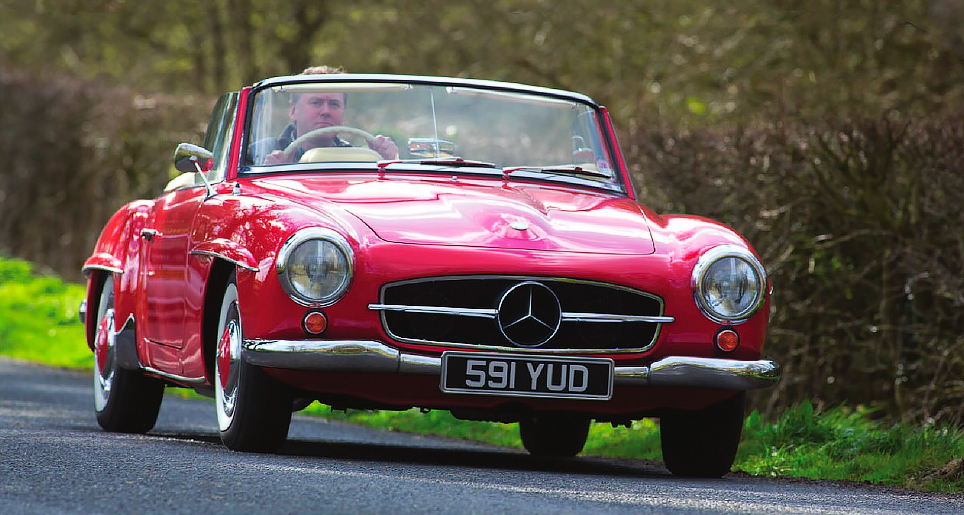
“Like most cars of its generation, the 190SL demands a concentrated input from its driver – you cannot be lazy with it”
The cream coloured, large-diameter steering wheel – the exact opposite of the small, thick, leather trimmed item of almost every Mercedes nowadays – looks wonderful, and rather than the direction indicators being on a stalk, they are operated by pulling down on the left or right; spoke of the wheel’s inner chrome ring. It’s a nice detail – but one which recently confused an MOT tester, who didn’t know they were there and, until the owner pointed out his mistake, was about to fail the car on non-functioning indicators. This 1960 car has the optional side facing rear seat, which can be removed to leave the normal flat area behind the front seats.
It looks like a scaled down 300SL, but on the road the 190SL is a totally different proposition.
It is not the road-going race car that the space-framed, fuel-injected 300SL W198 was, but a pleasant, open-topped two seater with sprightly rather than intense performance. Whereas the 300SL strikes up a stirring cacophony of mechanical sounds and vibrations, the 190SL’s 1.9-litre four-cylinder is mundane by comparison, and less communicative. No surprise that by today’s standards its pace is quite pedestrian, but with its twin carburettors it has a lively pick up and also quite a rorty sound.
Like most cars of its generation, the 190SL demands a concentrated input from its driver – you cannot be lazy with it, as you can with just about any modern Mercedes or, indeed, any other car. Constant corrections to the vague steering (although at 3.5 turns lock to lock it is not low-geared) are necessary to maintain course, and for neat shifting of gears you must carefully, but quickly, guide the spindly and vague feeling lever into its correct gate. Double declutching – selecting neutral and releasing the clutch, briefly revving the engine, dipping the clutch again and quickly slotting the lower gear in before the revs die to equalise cog speeds – pay dividends when downshifting, making the process much smoother. The 190SL is, indeed, from a far off generation of cars – which, of course, is part of its considerable charm.
“It became increasingly clear, even before the 300SLs launch, that there would be strong demand for a less exotic, more affordable stablemate.
ABOVE
Limited power but the twincarbs pick up well.
ABOVE RIGHT
The fascia has a full
complement of dials.
THIS PICTURE
190SL is as sleek at the tail as at the front end.
| Car | Mercedes-Benz 190SL W121 |
| Sold/number built |
1955-1963/25,881 |
| Construction |
steel body |
| Engine |
M121 1,897cc 4-cyl in-line |
| Max power | 104bhp @ 5,700rpm |
| Max torque |
105lb ft @ 3,200rpm |
| Transmission | four-speed manual |
| Drive | driving rear wheels |
| Suspension: | |
| front |
independent by upper wishbones and transverse leaf spring, anti-roll bar |
| rear |
independent; telescopic dampers f/r |
| Steering | rack and pinion |
| Brakes | dual-circuit drums |
| Wheels | – |
| Length | |
| Width | |
| Height | |
| Wheelbase | |
| Weight |
1,140kg |
| 0-62mph | 14,5sec (test 2014) |
| Top speed | 113mph (test 2014) |
| Mpg | 32.8 (test 2014) |
| Price new | – |





